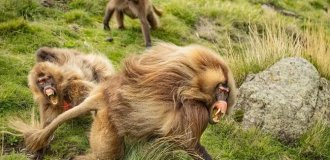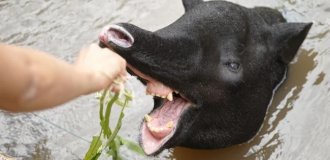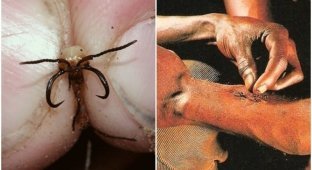Aardvark: a funny animal, thanks to which many animals in Africa have a roof over their heads (8 photos)
An aardvark living in Africa solves the housing problem for many animals, although he himself does not know about it. 
Meet the main developer in all of Africa.
But even if he had known, it is unlikely that the lop-eared navvy would have said anything against it. Digging is its element; the aardvark digs in the ground on a constant basis. Just five minutes - and the skillful animal has already dug a meter-long trench! And so every night and several times. He doesn’t have much of a choice; going underground is the only way to get to his dinner—termites and ants. 
The pig's coin unmistakably leads the animal towards the accumulation of sour butts. The aardvark's nose contains nine olfactory bulbs - more than any other mammal! Our friend will walk up to 30 km per night for the sake of insects! And once the target is discovered, he begins the genocide of the ant population. 
The destruction that the aardvark brings to the microworld is truly enormous: in one judgment night he will take up to 50 thousand insects! This is understandable: our friend is unable to eat anything other than ants and termites, so he needs to eat a lot of insects. The teeth for the aardvark are vestigial. The food that really chews is... the stomach. The powerful walls crush swallowed insects no worse than the jaws. 
Despite the meager diet, the animal grows to 60–80 kg. But compared to other relatives, the aardvark is tiny. The closest relatives of this wonderful cross between an opossum, a rat, a hare and a pig are, suddenly, elephants, dugongs and manatees! From his ancestors, the aardvark received a powerful gift - thick skin. It is she who helps him ignore the fierce resistance of insects. 
After the meal, the aardvark will again go underground, but to its lair. The animal spares no time and effort in caring for its beloved animal - the animal’s mansion can easily accommodate a person! But the big-eared realtors can boast of not only spaciousness - the hole has several entrances and several rooms with different purposes. 
But what aardvarks don’t like in their underground life is stagnation. They rummage through their apartment, rearrange the rooms, and sometimes even dig a new home for themselves. All this soul-searching does not go unnoticed by others. Before the aardvark has time to build himself a new hut, someone is already celebrating a housewarming in the old one. Everything from small animals to wild dogs and hyenas live in the dwellings dug by the animal. This is understandable; it’s difficult with landlords in the savannah. 
This is why the offspring of aardvarks do not immediately move away from their parents. The new generation is weaned at three months, and after six months it can already dig its own holes. But the young prefer not to dive into complete independence right away, but to sit on their parents’ neck for another year or two. And only then plunge headlong into the life of African diggers! 
How is it that the animal’s paws don’t wear out from such stubbornness? This is all thanks to the compacted, rough, spongy bone in the aardvark's limbs. These bones are softer than normal ones, but they react much more easily to powerful shocks and deformations. Spongy bone is formed in many animals during the early stages of development. But after that it disappears and remains only in the aardvark and extremely small species of rodents and primates.






















